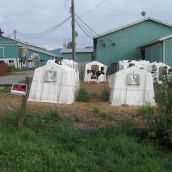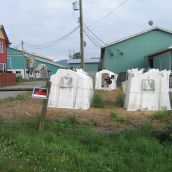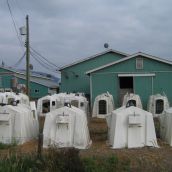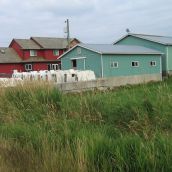PHOTOGRAPHY about SolidarityPolice/PrisonsPeace/WarIdeasHousingHealthFoodEnvironmentEducationDirect Actionposted on Août 6, 2013 by fortotalliberation
veal: why are we not attacking everything all the time?
This farm is just one of many in Chilliwack/Abbotsford that keeps the dairy industry afloat. It's location is 1.5 km east of Whatcom Road on the south side of South Perimeter Road. The babies in these photos are clearly visible from Highway 1.
~@~
Walking through a clearcut knowing humans stole the forest for profit, seeing baby calves watching you curiously with the knowledge that they are about to be killed so capitalists can get richer, hearing the reports on the hunger strikers at Guantanamo, Nazi hate crimes rising everywhere (yep), listening to reports of another trans woman murdered violently in her home... All these things work hard to break us down, to destroy our fighting spirit and to overwhelm us with the bodily knowledge that this society acts violently upon us every fucking day.
Why are we not attacking everything all the time? Not only is it easy, so we hear, (and a brief flirtation with liberation), but there are so many forces maintaining the violent and bloody status quo that you can pretty much look anywhere and see something worthy of destroying.
About these photos: the calves in these pictures are products of the dairy industry. Their mothers were forcibly impregnated (by a machine called a rape rack in the industry) and upon giving birth, had their children stolen from them to be turned into veal, and got hooked up to machines which will suck the milk out of them, causing infection and udder deformity, while they will watch and hear their babies be taken to slaughter. The mother cows are in the barn just behind the veal crates.
And just a note on the lives of these babies- they have about 6' by 3' pens, barely big enough to turn around in, to live in for the few weeks that they are alive before they are killed. They are fed liquid diets which cause them severe anemia so that their meat is desirable by industry standards. Their slaughter will be a throat slitting and then likely a dunk into a boiling tub of water to de-hair them, which often happens while they are still alive and bleeding out.
The site for the Vancouver local of The Media Co-op has been archived and will no longer be updated. Please visit the main Media Co-op website to learn more about the organization.




Commentaires
It's helpful to know facts
It's helpful to know facts before you begin fabricating things such as these calves in these "6' by 3' pens" being kept for slaughter. In fact, I would bet, that those calves are being raised are ALL heifers (which are female cows that have never calved, for the uneducated), and are put in those pens, individually, so they can be given milk 2+ times a day. Those doors on the sides of those hutches; their purpose is for putting forage and grain in buckets just inside the hutch, to keep their non-liquid part of their diet dry. This begins their digestive system, so their rumens begin to function healthily. They are also put into these individual pens to prevent the spread of any illness or diseases that accompanies any sort of livestock (including cattle where the cow and calf pair are kept together until weaning later on in life), This is especially critical since babies have no immune system when they are born. These individual pens also help to monitor their feed intake, which help detect abnormalities.
As for their mothers being "forcibly impregnated (by a machine called a rape rack in the industry)"; look up what a rape rack is. Artificial insemination is harmless, if that's what that particular dairy farm uses. Many farms have a bull that inseminates their cows, when they are in heat. There's no forcefullness to it; they are actually more than willing. Post-calving, (which their babies are put into hutches at times that can vary from several days, to several weeks, depending on the farm), they are milked. This includes various machines, which can be individual pails hooked up to a compressor, to a parlor system which has a vacuum system hooked up to multiple machines, or even a robotic milking system, which replaces the person that individually cleans and ensures the health of each quarter on the udder. Cows, like humans or any lactating mammal, are sucseptible to mastitis. As our technology evolves, so does our ability to detect such infections before they happen, and treat accordingly. Robotic milking systems are helpful in detecting mastitis, and any other illness a cow may acquire, even before they begin showing external symptoms.
Why are we not attacking everything all the time? Most of the time, there's nothing to attack. There's bad, and there's also good; helps to look at the bigger picture.
.
.